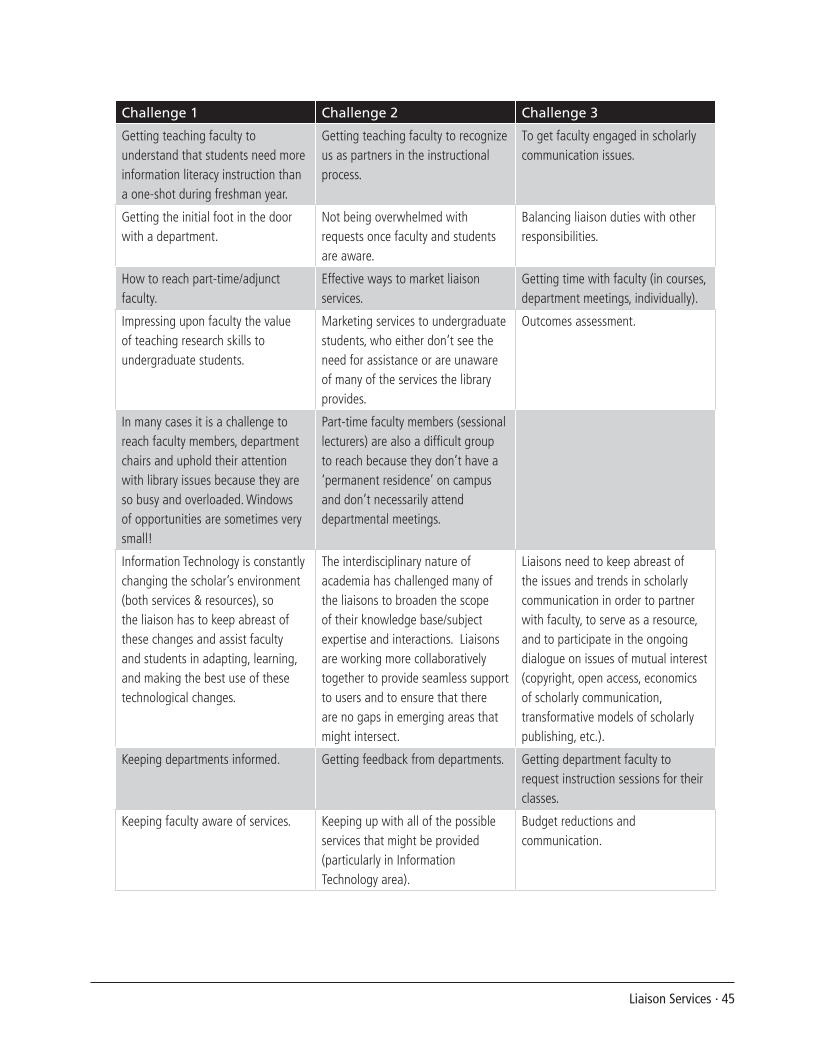Liaison Services · 45
Challenge 1 Challenge 2 Challenge 3
Getting teaching faculty to
understand that students need more
information literacy instruction than
a one-shot during freshman year.
Getting teaching faculty to recognize
us as partners in the instructional
process.
To get faculty engaged in scholarly
communication issues.
Getting the initial foot in the door
with a department.
Not being overwhelmed with
requests once faculty and students
are aware.
Balancing liaison duties with other
responsibilities.
How to reach part-time/adjunct
faculty.
Effective ways to market liaison
services.
Getting time with faculty (in courses,
department meetings, individually).
Impressing upon faculty the value
of teaching research skills to
undergraduate students.
Marketing services to undergraduate
students, who either don’t see the
need for assistance or are unaware
of many of the services the library
provides.
Outcomes assessment.
In many cases it is a challenge to
reach faculty members, department
chairs and uphold their attention
with library issues because they are
so busy and overloaded. Windows
of opportunities are sometimes very
small!
Part-time faculty members (sessional
lecturers) are also a difficult group
to reach because they don’t have a
‘permanent residence’ on campus
and don’t necessarily attend
departmental meetings.
Information Technology is constantly
changing the scholar’s environment
(both services &resources), so
the liaison has to keep abreast of
these changes and assist faculty
and students in adapting, learning,
and making the best use of these
technological changes.
The interdisciplinary nature of
academia has challenged many of
the liaisons to broaden the scope
of their knowledge base/subject
expertise and interactions. Liaisons
are working more collaboratively
together to provide seamless support
to users and to ensure that there
are no gaps in emerging areas that
might intersect.
Liaisons need to keep abreast of
the issues and trends in scholarly
communication in order to partner
with faculty, to serve as a resource,
and to participate in the ongoing
dialogue on issues of mutual interest
(copyright, open access, economics
of scholarly communication,
transformative models of scholarly
publishing, etc.).
Keeping departments informed. Getting feedback from departments. Getting department faculty to
request instruction sessions for their
classes.
Keeping faculty aware of services. Keeping up with all of the possible
services that might be provided
(particularly in Information
Technology area).
Budget reductions and
communication.
Challenge 1 Challenge 2 Challenge 3
Getting teaching faculty to
understand that students need more
information literacy instruction than
a one-shot during freshman year.
Getting teaching faculty to recognize
us as partners in the instructional
process.
To get faculty engaged in scholarly
communication issues.
Getting the initial foot in the door
with a department.
Not being overwhelmed with
requests once faculty and students
are aware.
Balancing liaison duties with other
responsibilities.
How to reach part-time/adjunct
faculty.
Effective ways to market liaison
services.
Getting time with faculty (in courses,
department meetings, individually).
Impressing upon faculty the value
of teaching research skills to
undergraduate students.
Marketing services to undergraduate
students, who either don’t see the
need for assistance or are unaware
of many of the services the library
provides.
Outcomes assessment.
In many cases it is a challenge to
reach faculty members, department
chairs and uphold their attention
with library issues because they are
so busy and overloaded. Windows
of opportunities are sometimes very
small!
Part-time faculty members (sessional
lecturers) are also a difficult group
to reach because they don’t have a
‘permanent residence’ on campus
and don’t necessarily attend
departmental meetings.
Information Technology is constantly
changing the scholar’s environment
(both services &resources), so
the liaison has to keep abreast of
these changes and assist faculty
and students in adapting, learning,
and making the best use of these
technological changes.
The interdisciplinary nature of
academia has challenged many of
the liaisons to broaden the scope
of their knowledge base/subject
expertise and interactions. Liaisons
are working more collaboratively
together to provide seamless support
to users and to ensure that there
are no gaps in emerging areas that
might intersect.
Liaisons need to keep abreast of
the issues and trends in scholarly
communication in order to partner
with faculty, to serve as a resource,
and to participate in the ongoing
dialogue on issues of mutual interest
(copyright, open access, economics
of scholarly communication,
transformative models of scholarly
publishing, etc.).
Keeping departments informed. Getting feedback from departments. Getting department faculty to
request instruction sessions for their
classes.
Keeping faculty aware of services. Keeping up with all of the possible
services that might be provided
(particularly in Information
Technology area).
Budget reductions and
communication.












































































































































































